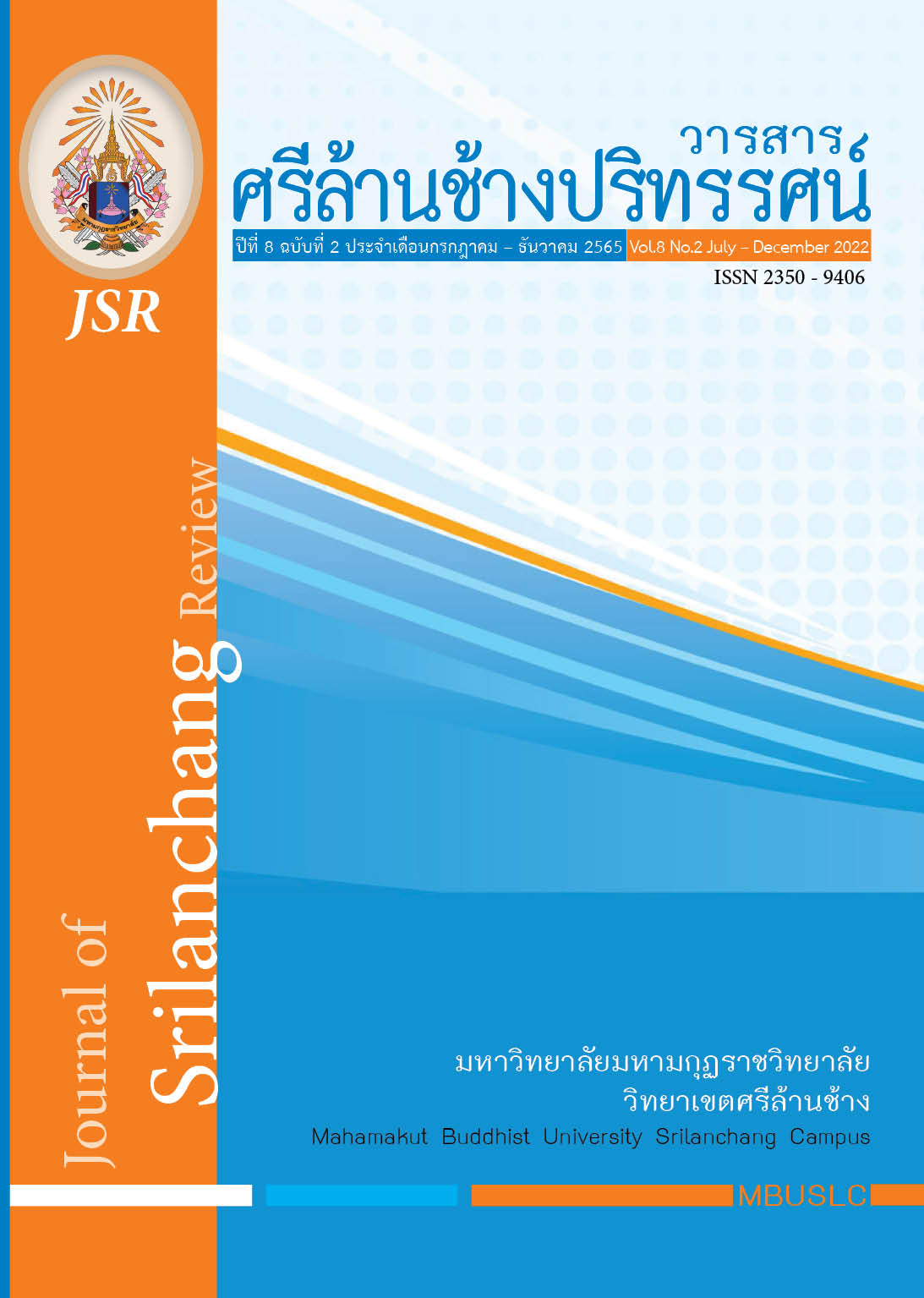THE SUSTAINABLE ARTS AND CULTURE PRESERVATION OF NAKHON CHAIBURIN CLUSTER RAJABHAT UNIVERSITY
Main Article Content
Abstract
This article is a part of the research on the strategy for arts and culture sustainable preservation at Nakhon Chaiburin Cluster Rajabhat University. Its purpose was to study the context of sustainable arts and culture preservation of the Nakhon Chaiburin Cluster Rajabhat Universities and to analyze the strengths, weaknesses, opportunities, and threats (SWOT) of sustainable arts and culture preservation of the Nakhon Chaiburin Cluster Rajabhat Universities. The research method used was a mixed-method. The Key information target group was 20 people, including the Director, Deputy director of the Office of Arts and Culture of Nakhon Chaiburin Cluster Rajabhat University, Provincial Culture of Nakhon Chaiburin Cluster. The research instruments consisted of an in-depth interview and a SWOT assessment form. The data was analyzed using content analysis and average. The research results revealed as follows; 1) The Context of Sustainable Preservation of Arts and Culture of Nakhon Chaiburin Cluster Rajabhat Universities involved three parts; the mission of preserving arts and culture, the internal environment, and the external environment. 2) The analysis of SWOT reveals that the strengths are very low, with an average of 1.47. The Weaknesses (W) Weaknesses are very low-level, with an average of -0.95. The opportunities are low, with an average of 2.28 and the threat level was very low, with an average of -1.83.
Article Details

This work is licensed under a Creative Commons Attribution-NonCommercial-NoDerivatives 4.0 International License.
บทความที่ได้รับการพิจารณาจากคณะกรรมการผู้ทรงคุณวุฒิและเผยแผ่ในวารสารฉบับนี้ เป็นทัศนคติและข้อคิดเห็นส่วนบุคคลของผู้เขียนแต่ละท่าน ไม่ถือว่าเป็นทัศนะคติและความรับผิดชอบ
ของบรรณาธิการ
บทความ ข้อมูล เนื้อหา รูปภาพ ฯลฯ ที่ได้รับการตีพิมพ์ในวารสารศรีล้านช้างปริทรรศน์ ถือเป็นลิขสิทธิ์ของวารสารศรีล้านช้างปริทรรศน์ หากบุคคลหรือหน่วยงานใดต้องการนำทั้งหมดหรือส่วนหนึ่งส่วนใดไปเผยแพร่ต่อหรือเพื่อกระทำการใด ๆ จะต้องได้รับอนุญาตเป็นลายลักอักษรจากวารสารศรีล้านช้างปริทรรศน์ ก่อนเท่านั้น
References
กิตติ ประเสริฐสุข. (2018). Soft Power ของเกาหลีใต้: จุดแข็งและข้อจำกัด. International Journal of East Asia Studies, 22(1), 122-139Z.
ธนิก เลิศชาญฤทธ์. (2554). การจัดการทรัพยากรวัฒนธรรม. กรุงเทพฯ : ศูนย์มานุษยวิทยาสิรินธร (องค์การมหาชน).
นันทิพา บุษปวรรธนะ และ นาวิน วงศ์สมบุญ. (2563). ความสำเร็จในการเผยแพร่กระแสวัฒนธรรมเกาหลี(Korean Wave): บทบาทของรัฐบาลและอุตสาหกรรมสื่อบันเทิง. วารสารราชภัฏสุราษฎร์ธานี. 7(2). (กรกฎาคม – ธันวาคม). 1-25.
ประกาศคณะกรรมการนโยบายการบริหารงานจังหวัดและกลุ่มจังหวัดแบบบูรณาการ เรื่อง การจัดตั้งกลุ่มจังหวัดและกำหนดจังหวัดที่เป็นศูนย์ปฏิบัติการของกลุ่มจังหวัด ฉบับที่ 3 2560. (2560). ราชกิจานุเบกษา. เล่ม 134. ตอนพิเศษ 281 ง.
พระราชบัญญัติมหาวิทยาลัยราชภัฎ 2547. (2547). ราชกิจจานุเบกษา. เล่มที่ 125. ตอนพิเศษ 23 ก หน้า 1.
ไพฑูลย์ สินลารัตน์. (2526). บทบาทของมหาวิทยาลัยไทยในการสร้างเสริมศิลปวัฒนธรรมไทย. กรุงเทพฯ : โรงพิมพ์จุฬาลงกรณ์มหาวิทยาลัย.
พฤทธิ์ ศิริบรรณพิทักษ์. (2562). เทคนิคและเครื่องมือการวางแผนด้านการศึกษา : เอกสารประกอบการบรรยาย หลักสูตรปรัชญาดุษฎีบัณฑิต สาขาวิชาการบริหารการศึกษา. นครราชสีมา: บัณฑิตวิทยาลัย มหาวิทยาลัยราชภัฎนครราชสีมา.
รุ้งลาวัลย์ สกุลมาลัยทอง. (2560). กลยุทธ์การเสริมสร้างวัฒนธรรมสร้างสรรค์ในถาบันอุดมศึกษาไทย. วิทยานิพนธ์ดุษฎีบัณฑิต. สาขาการอุดมศึกษา ภาควิชานโยบายการจัดการและความเป็นผู้นำการศึกษา. คณะครุศาสตร์ มหาวิทยาลัยจุฬาลงกรณมหาวิทยาลัย.
อเนก เหล่าธรรมทัศ, (2561). ทัชช่า. ออนไลน์. สืบค้นเมื่อ 20 พฤศจิกายน 2565. แหล่งสืบค้น https://www.mhesi.go.th/index.php/en/all-media/infographic/2883-2020-12-28-03-30-23.html
Dobroslawa, Wiktor-Mach. (2020). What role for culture in the age of sustainable development? UNESCO’s advocacy in the 2030 Agenda negotiations. International Journal of Cultural Policy, 26(3). 312-327, DOI: 10.1080/10286632.2018.1534841
Hawkes, Jon. (2001). The Fourth Pillar of Sustainability): Culture’s Essential Role in Public Planning. Victoria: Common Ground Publishing Pty Ltd. in association with the Cultural Development Network (Vic).
Kiran Prasad Editor (editor). (2018). Communication, Culture and Change in Asia. Springer (eBook), Retrieved September 1, 2021, from https://doi.org/10.1007/978-981-10-7104-1
Lale, A. (2020). The Soft Power of South Korea. Asya Studies-Academic Social Studies/Akademik Sosyal Araştırmalar, 4(13). (Autumn) 63-74.
Nancy Duxbury, Anita Kangas & Christiaan De Beukelaer. (2017). Cultural Policies for Sustainable Development: Four Strategic Paths. International Journal of Cultural Policy, 23(2). 214-230
Peter F. Drucker.(2008). Management. Revised Edition. Harper Business.
UNESCO. (1972). The World Heritage Convention. Retrieved August 4, 2021, from https://whc.unesco.org/
en/convention/
UNESCO. (2015). UNESCO’s Work on Culture and Sustainable Development Evaluation of a Policy Theme. Retrieved August 4, 2021, from https://unesdoc.unesco.org/ ark:/48223/pf0000234443


